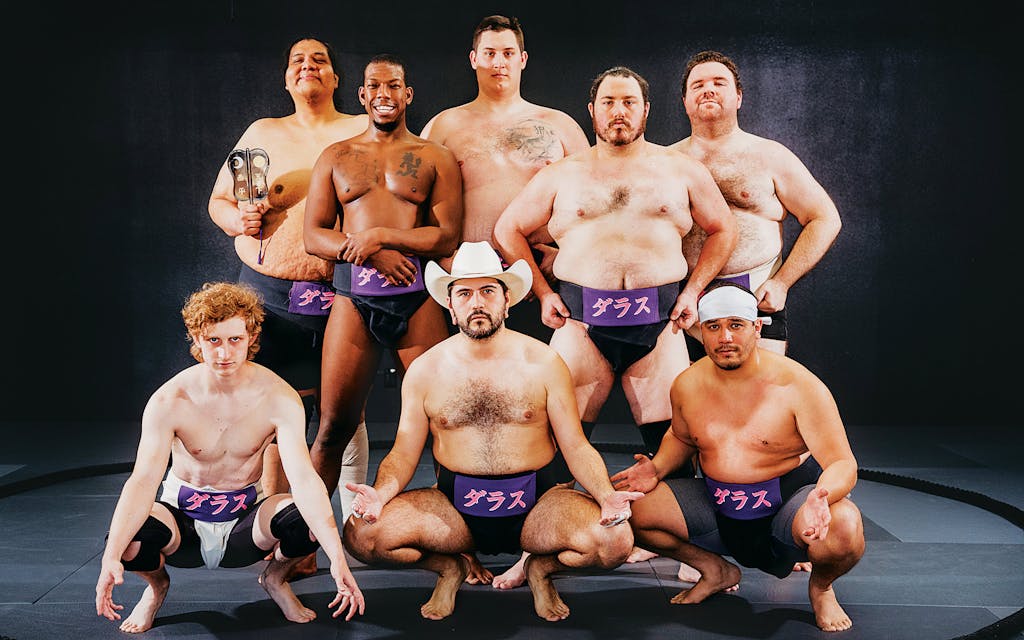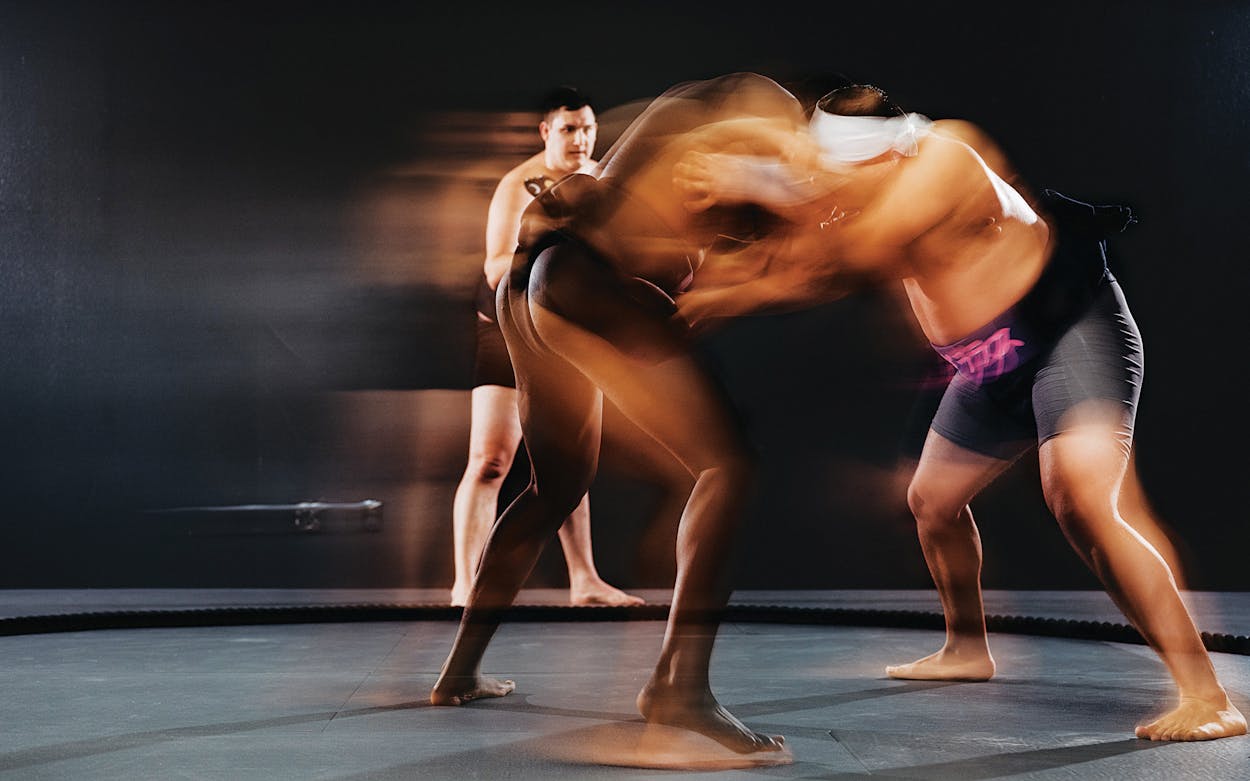Featured in the Dallas City Guide
Discover the best things to eat, drink, and do in Dallas with our expertly curated city guides. Explore the Dallas City Guide
Before the Dallas Sumo Club, I’m told, all that popped up when you googled “sumo wrestling Dallas” were links to those goofy inflatable sumo suits. You know the kind. You can rent them for parties. Ed Sheeran wore one in his video for “Shape of You.” Ellen DeGeneres periodically sticks her guests in them as a gag. For a long time, that’s what sumo has been in the United States: a punch line.
A brief introduction to the sport, with no input from music videos or daytime television clips: sumo dates as far back as the first century AD, with roots in Japanese Shinto rituals that honored the gods and encouraged a bountiful harvest. These spiritual traditions are deeply embedded in its DNA, especially in professional sumo in Japan, where referees dress as Shinto priests and perform pre-match purifying rituals in the dohyō, the roughly fifteen-foot ring in which bouts take place. Beyond that, once fighters are familiar with the sport’s banned moves, the basic rules are pretty simple: two wrestlers face off, and the first person to step out of the ring or touch the ground with any part of their body other than the sole of a foot loses.
Dallasite Corey Morrison didn’t know any of that in 2019, when he was whiling away hours on YouTube and happened upon a documentary about Chiyonofuji Mitsugu, one of the most celebrated sumo wrestlers in recent history. Morrison, then 31, was aware of Western stereotypes of sumo wrestlers as “fat guys in diapers.” But here was Chiyonofuji, a chiseled fighter with deltoid muscles like cantaloupes and lats like bat wings—“really just a gorgeous man,” Morrison recalled wistfully. Chiyonofuji was grappling with much larger fighters with a kind of strength and agility Morrison had never seen before. He was spellbound.
He showed his girlfriend, Siggy Sauer, the documentary, and soon she was hooked too. The two started following pro sumo, staying up into the wee hours to stream the matches live. Sometimes they would post clips of fights on Instagram. One day, a man named Justin Kizzart messaged Morrison. He ran a club in Austin called Dark Circle Sumo. Would he and Sauer like to come down and try it out for themselves?

Sauer, Morrison said, enjoyed their visit, but he wasn’t initially sure sumo was for him—mostly because of the broken bones. The practice was brutal. He threw up multiple times (granted, he was pretty hungover from a wedding reception), and his body snapped like a cracker when a guy hurled him down onto the mat. The fall fractured three of his ribs. This early skeletal trauma ultimately didn’t deter him, though. Kizzart encouraged Morrison to contact sumo fans in Dallas, and another club leader gave him an email list of enthusiasts in the Metroplex. Over the next few months, as his ribs healed, he reached out to the aspiring sumo wrestlers on the list. In January 2021, the Dallas Sumo Club was born.
The group has already garnered some buzz: the Dallas Morning News ran a story, and Spectrum News aired a segment that I happened to catch one day in November while running on a treadmill at the gym.
Maybe it was the incongruous combination of sumo belts and Morrison’s cowboy hat that made me pause my workout to watch. Maybe it was the confused faces of passersby stumbling upon half-clothed men hurling each other around at a Wednesday morning practice in Kidd Springs Park. Or maybe I was just looking for an excuse to stop running.
In any case, a few weeks later, on a bright Sunday morning in late December, I drove up to a small jiujitsu gym in North Dallas. There, I found Morrison unpacking Santa hats and tinsel from a cardboard box.
“We did this Halloween video where we’re all dressed up, and it got a good response online, so I wanted to do something Christmasy,” Morrison explained as he set up cameras to record their practice and I walked around, tripping over wires. “A regular practice is called keiko. So we’re doing keiko-mas.”
On the day we met, Morrison was wearing shorts and a blue-and-purple tie-dyed Buc-ee’s hoodie. His floppy black hair was trimmed into a trendy undercut, and his earlobes hung loose and low, stretched by gauges. He weighed exactly two hundred pounds, according to the scale he stepped on mid-practice. When he’s not tossing other fighters around in the ring, Morrison freelances as a director of photography for films and music videos. He’s been using his skills (and video equipment) to produce social media content for the club. In addition to Facebook posts and YouTube videos, the group also livestreams every practice on Instagram.
While Morrison prepared the Christmas decorations, four other members drifted in: Jared Tadlock, a 33-year-old former pro wrestler who first became interested in sumo after once catching a match on ESPN at 3 a.m.; 31-year-old Albert Martinez, a soft-spoken veteran of the Marines; Stephen Pretto, a pale, slender 28-year-old who rode a motorcycle across Japan in 2017 to watch a sumo tournament; and Matt Jim, who is 40 and an avid fan of all kinds of wrestling, including Turkish oil wrestling and Senegalese Laamb.


Khalil Collins, a 26-year-old mixed martial arts fighter and former football player, also came to observe but said he wouldn’t be participating because he had broken a finger and suffered a tear in one ankle at the North American Sumo Championships the week before. Instead, he watched from the sidelines, occasionally piping up to offer tips to his teammates.
The club typically has around fifteen members. Currently, all its members are men, but they’re eager for women to join. Although the Japan Sumo Association, the governing body behind pro sumo in Japan, prohibits women from even entering the dohyō, women across the world practice at an amateur level. Heavyweight Eros Armstrong, of Austin’s Dark Circle Sumo, will participate in the 2022 World Games, which will be held in July in Birmingham, Alabama, and another woman from the club is an alternate. Some of the guys in Dallas have tried to get their girlfriends to come to practices—Sauer, Morrison said, doesn’t practice often because she works as a go-go and burlesque dancer and worries about getting injured. Jim spoke admiringly of the strength of his roommate, who once moved a huge recliner in their apartment. “I know she’s gonna have fun throwing me around,” he said with a laugh.
One by one, the men all stripped down to their boxer briefs and tied on their sumo belts, or mawashis. (Only a few fighters among them wear the mawashi in the traditional style, without anything underneath.) Each mawashi is about thirty feet long and is wrapped between one’s legs and around the waist, then tied in back. Ensuring the belt is secure enough to withstand battle is often a two-person job, and pained groans occasionally floated up from around the gym as one man would yank his partner’s belt more tightly around his torso.
Finally, the stage was set for keiko-mas. Morrison had pinned four red stockings neatly to the wall, wrapped the dohyō in cheery green tinsel, and placed a small Christmas tree in the center of the ring. Ever the director, he turned the cameras on and carefully arranged himself and his teammates around the tree so they’d be correctly centered in the frame. For the introduction to the YouTube video he was making, the fighters donned Santa hats or reindeer antlers and squatted around the tree like Santa’s most intimidating and scantily clad elves. Then, the tree was removed and the festive headgear discarded. The guys began to warm up. After a few exercises, Morrison clapped his hands together and grinned.
“Let the violence begin.”
Outside Japan, sumo has developed a following over the past few decades in Mongolia and Eastern Europe. In 2008 a Bulgarian wrestler, Kotoōshū Katsunori, became the first European to win a Grand Sumo Tournament. A few prominent Hawaiian sumo wrestlers have also earned international attention, including Akebono Tarō, who in 1993 became the first-ever non-Japanese wrestler to become a yokozuna, the highest rank in professional sumo. In the mainland U.S., though, the sport is still in its infancy.
There are now five official sumo clubs recognized by the United States Sumo Federation in Texas alone, more than in any other state. Groups practice in Austin, Dallas, and San Antonio, and near Houston. The Dallas Sumo Club is one of the newest. Of its fifteen current members, Morrison said, ten are “solid” and show up to most of the practices, while five are “hard-core” and are already going to competitions.
“Our goal is to let people know that this is a sport in the U.S.,” said Kizzart, who, in addition to his work with the rib-cracking Dark Circle Sumo, is a trustee on the board of the USSF. Kizzart has been practicing sumo for about six years. When he started competing, he said, there might have been five or six other athletes in his weight class at any given event—but in the past two years the numbers have exploded. At the 2021 North American Sumo Championships, in Las Vegas, he recalled, “it was definitely a long haul to get through all those brackets.”
What’s more satisfying than watching other humans flip each other like flapjacks? It’s the kind of beautiful, controlled brutality that scratches an itch deep at the base of our ids.
But as more Americans take up the sport, practitioners are trying to be mindful about balancing their desire for growth with their desire to honor sumo’s cultural origins—to make sure it’s not treated as a joke. “We don’t want to come from a disrespectful angle,” Tadlock told me as he wrapped Christmas presents before practice. “That was very important to us as a club from the jump.”
The ritual and showmanship are part of sumo’s draw. “There’s a lot of pageantry,” Morrison explained. “Aside from being wrestlers, sumo wrestlers are expected to be entertainers.” But the appeal is also more basic than that, more universal. What’s more satisfying than watching other humans flip each other like flapjacks? It’s the kind of beautiful, controlled brutality that scratches an itch deep at the base of our ids.
And it’s really damn exciting. Sumo matches can be blink-and-you’ll-miss-it fast. In the time it takes for your eyelids to lower, lubricate your corneas, and raise themselves again, the dynamic in the ring may have completely changed or fully resolved itself, with one athlete suddenly standing victorious over another. Most sumo matches, Kizzart told me, last less than a minute.
Perched ringside watching the men in Dallas spar, I felt the muscles of my face cycle through every expression of human emotion, like one of those charts child psychologists show little kids to help them identify their feelings: surprise when Tadlock flipped Morrison flat onto his back; fear when it seemed that Jim and Morrison, locked in a vicious but tender-looking embrace, were about to collapse on top of me and squish me down through the earth’s crust and deep into its inner core; delight when they didn’t.
By now, the guys are familiar with one another’s fighting styles. Morrison is moving toward a “pushing and thrusting” style with “a lot of neck hits,” while Martinez describes himself as “more of a belt person,” which means he’ll grab an opponent by the mawashi during the bout to yank him off balance. During practice, the men try to spar with every other fighter once so they can prepare to face different techniques.
None of the members of the Dallas Sumo Club are trained professionals. As a result, they all end up coaching one another, like a combat co-op. There are 82 kimarite, or winning techniques, in sumo, Morrison explained as he rested between bouts. Club members pick the moves they want to practice, and Tadlock, the most experienced wrestler of the group, will either break down the techniques for them or look up YouTube videos that do so. “Here, we all do lean on each other, for sure,” Morrison said, before admitting, “It has its ups and downs.”


In July 2017, a month before his first prize fight against boxer Floyd Mayweather, the Irish mixed martial arts fighter Conor McGregor showed up to his and his opponent’s first joint press appearance in a custom three-piece pin-striped suit. It was a good outfit—beautiful fabric, well tailored. The pinstripes, if you looked really closely, all said “F— you.”
The gesture was extravagant but pretty much par for the course for an MMA fighter like McGregor, whose sport is laced with athletes’ trash talk. It’s exactly the kind of hyper-macho, aggressive behavior that the sumo community in the United States wants to avoid.
“Every now and then, you get one or two meatheads who come into the sport and try to bring what I call ‘little dick energy,’ ” said Kizzart. “And they instantly feel like they’re the outsider, because they’re way too aggressive. It’s funny because the nicer guys with more techniques tend to beat those guys who go in and think they’re going to just muscle somebody out of the ring.”
Indeed, the general atmosphere of the Dallas Sumo Club is overwhelmingly warm and supportive, more group therapy than combat training. When Morrison expressed disappointment at his showing at the North American Sumo Championships the week before, his teammates rushed to cheer him up. “I watched them all,” Pretto said of Morrison’s matches. “You had the fighting spirit. You went into every match, and I could tell you were ready to kill. It wasn’t that you were giving up. I was super proud of you.”
As practice came to an end, Jim, who is a member of the Pawnee Nation, said he wanted to take sumo back to his hometown, Pawnee, Oklahoma, to help kids in his community gain confidence and strength. Earlier, as he was adjusting his mawashi before the warm-up, Jim told me that he had quit drinking a few years ago, and that for a while after he got sober, he’d felt adrift. “Sumo is what saved me,” he said. “It dragged me out of the clutches of depression, and it helps me manage my anxieties. If I start feeling a certain way, I do some exercises, because my body is something I do have control over.”
The group is hoping to expand and draw in more members this year—men, women, old, young, big, small, former athletes and lifelong couch potatoes, Jim’s recliner-hauling roommate. Anyone, they say, can benefit from getting in the dohyō a couple of times a week.
“When I walk past some big guys now,” Morrison told me, “I wish I had a business card or something so I could be like, ‘Hey, you want to go somewhere where you are revered as beautiful? Where you are the Marilyn Monroe when you step into the ring?’ That’s sumo.”
Madeleine Aggeler is a writer who lives in Austin.
This article originally appeared in the March 2022 issue of Texas Monthly with the headline “Sumo Is Getting Big.” Subscribe today.







